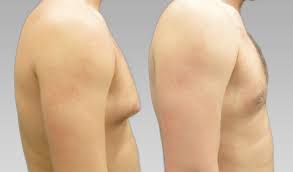Gynecomastia Surgery
Gynecomastia Surgery
Gynecomastia surgery, also known as male breast reduction surgery, is the most effective treatment for gynecomastia, the enlargement of the glandular component of the male breast, which removes excess fat and glandular tissue to restore a firmer, flatter, and more masculine contour to the chest. Gynecomastia is not normally a serious problem, but research shows that it can affect self-confidence and cause embarrassment.
All men and women have breast glands, but they are not noticeable in men, because they tend to be small and undeveloped. Due to hormonal changes, heredity, obesity, the use of certain medications, or other unspecified reasons, some men develop the appearance of enlarged breasts. Thus, gynecomastia does not mean that someone has extra fat from being overweight. It is caused by additional breast tissue. Doing exercise or losing weight will not reduce the breast tissue in gynecomastia. Gynecomastia can present at any age, and gynecomastia surgery can be performed safely and successfully on teenagers and adult men alike.
Gynecomastia Symptoms
- Swollen or prominent breast gland tissue
- Tenderness in the breast area
- Nipple discharge in one or both breasts
- Pain
- Asymmetrical chest tissue
If there is unusual and persistent swelling, tenderness, pain, or nipple discharge, or a combination of these, it is important to see a physician.
Why have Gynecomastia Surgery?
Gynecomastia surgery is the only consistently effective treatment for gynecomastia that has long lasting results. It can cause emotional discomfort, affect social functioning and impair self-confidence. Some men may even avoid certain physical activities simply to hide their condition, but following this surgery, patients report an enhanced sense of self-confidence, and say they feel comfortable going shirtless for the first time in years.
If you find yourself avoiding certain activities because of being afraid to show your chest, gynecomastia surgery is an option to consider. With the help of the qualified cosmetic surgeon, the procedure offers dramatic improvements with minimal scarring.
Who is a Good Candidate for Gynecomastia Surgery?
You may be a good candidate for gynecomastia if you:
- are generally in good health
- are dissatisfied with the appearance of your chest
- have enlarged breast tissue and excess skin
- have sought medical treatment for the underlying cause of gynecomastia
- are within normal body weight
- do not smoke
- have realistic expectations for surgical cosmetic achievement
- experience physical discomfort from oversized breasts
- have exhausted appropriate exercise and dieting routines
What does Gynecomastia Surgery Involve?
Gynecomastia surgery is usually carried out under general anesthesia.
Generally, the surgery involves:
- making an incision around the nipple
- using liposuction to suck out excess fatty tissue
- if there is a lot of tissue to remove, extending the incisions and repositioning the nipples may be necessary
The surgery takes about 1-2 hours and you usually need to stay in hospital overnight.
Gynecomastia Surgery Procedure
-
Liposuction Technique
Liposuction techniques alone may be used in cases where, gynecomastia is primarily the result of excess fatty tissue. This requires insertion of a cannula, a thin hollow tube, through several small incisions. So the surgeon makes a very small incision measuring 3-4 mm under each arm, and inserts a cannula into it to draw away any fatty deposits in the area. A smooth, thin layer of fat is left under the skin to ensure there is no rippling or irregularities in the area.
Next, he makes a small, crescent-shaped incision at the base of the areola, through which any excess glandular tissue is removed. Both incisions are left open to drain and should heal within a few days after surgery.
-
Excision Technique
In cases where, glandular breast tissue or excess skin must be removed to correct gynecomastia, excision techniques are recommended. Excision is also necessary if the areola will be reduced or the nipple will be repositioned to a more natural male contour. There are different incision patterns depending on the specific conditions and surgical preference.
-
Combination of Liposuction and Excision Techniques
Sometimes gynecomastia is treated with both liposuction and excision.
After your surgery, you will need to wear an elastic garment in order to control any post-operative swelling and to help your skin shrink to fit your new contour.
Recovery
During the recovery period, dressings or bandages will be applied to the incisions and an elastic bandage or support garment may be used day and night to minimize swelling and support the new chest contour as it heals after surgery. The stitches will be removed or may dissolve after a week or two. You should avoid stretching, strenuous exercise and heavy lifting for up to six weeks after surgery.
Although the recovery process depends on the recovery pace and your health condition, the average man who has a combination of liposuction and minimally invasive endoscopic gland tissue excision is able to return to work in about a week. So you may need to take a few days off work.
Results
You will notice a more contoured chest profile immediately after your procedure, with improved results as post-operative swelling subsides. Incision lines are permanent, but will continue to fade over time. It can take up to 3-6 months to see the full results. Gynecomastia surgery produces permanent results, as long as you maintain a stable body weight and avoid using steroids and other medicines or drugs that affect your testosterone levels.
Risks
Gynecomastia surgery risks include:
- Reactions to the material used in the surgery, such as glues, tape, and dressings
- Reaction to anesthesia
- Blood clots
- Excessive bleeding
- Changes in sensation in the nipples and/or breasts
- Deep vein thrombosis
- Infection
- Fluid accumulation (seroma)
- Scarring
- Poor healing of the wounds










Leave a Reply
Want to join the discussion?Feel free to contribute!